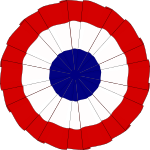民主共和黨
民主共和黨 Democratic-Republican Party | |
|---|---|
 民主共和黨标志 | |
| 领袖 | 湯瑪斯·傑佛遜 詹姆斯·麥迪遜 詹姆斯·門羅 安德魯·傑克遜 |
| 成立 | 1792年 |
| 解散 | 1825年 |
| 前身 | 反行政派 |
| 继承者 | 民主黨(傑克遜派) 国家共和党(反傑克遜派) |
| 意識形態 | |
| 政治立場 | 左翼[3][7] |
| 国际组织 | 無 |
| 官方色彩 | 紅色、白色和藍色 |
| 美國政治 政党 · 选举 | |
民主共和黨(英語:Democratic-Republican Party)是美國建國早期的一個政党。由美國開國元勳湯瑪斯·傑佛遜和詹姆斯·麥迪遜在西元1792年創建。
歷史
[编辑]民主共和黨的對立政黨是聯邦黨(又叫做聯邦同盟黨)。與聯邦黨相比,民主共和黨更強調各州的權力(States' rights),重視自耕農的權益,反對過份的聯邦主義和君主主義。主要支持地區是中西部和南部。支持者大部份都是鄉村地區的農民還有城市地區的工人,民主共和黨可被視為今日美國兩大黨派中民主黨的前身。
1792年,美國開國元勳湯瑪斯·傑佛遜和詹姆斯·麥迪遜創建美國民主共和黨。他們因為反對聯邦黨的領袖、時任美國財政部長的亞歷山大·漢密爾頓的經濟政策,退出聯邦政府,成為反對黨。
1796年的美國總統選舉,民主共和黨領袖傑佛遜輸給聯邦黨候選人、時任美國副總統的約翰·亞當斯,但傑佛遜是該次選舉得票數第二多的候選人而成為副總統,隨後憲法修正案區分總統和副總統候選人,使總統的對手不會因得票數第二而成為副總統。
1800年的美國總統選舉,傑佛遜在國會選舉人票中,擊敗尋求連任的亞當斯,終於當選總統,並於1804年通過美國憲法第十二修正案,獲得連任。之後,民主共和黨人麥迪遜和詹姆斯·門羅贏得之後的四次美國總統選舉,使得民主共和黨連續執政長達24年,使其主要競爭對手聯邦黨逐漸式微並融入民主共和黨。
1824年的美國總統選舉,由於民主共和黨未能協調出單一候選人,四名民主共和黨人同時參選,最終普選票和選舉人票為四人中最多的安德魯·傑克遜在眾議院選舉中未能獲國會眾議員的支持而落選,而是由亨利·克萊支持的約翰·昆西·亞當斯當選總統,而克萊則獲亞當斯任命為國務卿,此次選舉結果導致以民主共和黨和聯邦黨為背景的兩大派系就此溶解,轉為親傑克遜派(Jacksonian)和反傑克遜派(Anti-Jacksonian)的競爭。
1828年和1832年的美國總統選舉,分別由亞當斯、克萊與傑克遜對壘;亞當斯和克萊的支持陣營被稱為国家共和党(其後又成立輝格黨),而傑克遜的支持陣營則組成民主黨(Democratic Party)。
參見
[编辑]注释
[编辑]- ^ Ohio History Connection. Democratic-Republican Party. Ohio History Central. [2017-08-30]. (原始内容存档于2021-12-29).
Democratic-Republicans favored keeping the U.S. economy based on agriculture and said that the U.S. should serve as the agricultural provider for the rest of the world […]. Economically, the Democratic-Republicans wanted to remain a predominantly agricultural nation, [...].
- ^ Beasley, James R. Emerging Republicanism and the Standing Order: The Appropriation Act Controversy in Connecticut, 1793 to 1795. The William and Mary Quarterly. 1972, 29 (4): 604. JSTOR 1917394. doi:10.2307/1917394.
- ^ 3.0 3.1 Larson, Edward J. A Magnificent Catastrophe: The Tumultuous Election of 1800, America's First Presidential Campaign. 2007: 21. ISBN 9780743293174.
The divisions between Adams and Jefferson were exasperated by the more extreme views expressed by some of their partisans, particularly the High Federalists led by Hamilton on what was becoming known as the political right, and the democratic wing of the Republican Party on the left, associated with New York Governor George Clinton and Pennsylvania legislator Albert Gallatin, among others.
- ^ Adams, Ian. Political Ideology Today reprinted, revised. Manchester: Manchester University Press. 2001: 32 [2021-05-27]. ISBN 9780719060205. (原始内容存档于2021-12-16).
Ideologically, all US parties are liberal and always have been. Essentially they espouse classical liberalism, that is a form of democratized Whig constitutionalism plus the free market. The point of difference comes with the influence of social liberalism.
- ^ Wood, The American Revolution, p. 100
- ^ Democratic-Republican Party. Encyclopædia Britannica. 1998-07-20 [2017-08-30]. (原始内容存档于2018-06-15).
The Republicans contended that the Federalists harboured aristocratic attitudes and that their policies placed too much power in the central government and tended to benefit the affluent at the expense of the common man.
- ^ Ornstein, Allan. Class Counts: Education, Inequality, and the Shrinking Middle Class. Rowman & Littlefield Publishers. 9 March 2007: 56–58. ISBN 9780742573727.
